The Pennsylvania Railroad, legal name The Pennsylvania Railroad Company, also known as the "Pennsy", was an American Class I railroad that was established in 1846 and headquartered in Philadelphia. It was named for the commonwealth in which it was established. At its peak in 1882, the Pennsylvania Railroad was the largest railroad, the largest transportation enterprise, and the largest corporation in the world.

Under the Whyte notation for the classification of steam locomotives, a 2-10-4 locomotive has two leading wheels on one axle, usually in a Bissel truck, ten coupled driving wheels on five axles, and four trailing wheels on two axles, usually in a bogie. These were referred to as the Texas type in most of the United States, the Colorado type on the Burlington Route, and the Selkirk type in Canada.

A 2-8-8-4 steam locomotive, under the Whyte notation, has two leading wheels, two sets of eight driving wheels, and a four-wheel trailing truck. The type was generally named the Yellowstone, a name given it by the first owner, the Northern Pacific Railway, whose lines ran near Yellowstone National Park. Seventy-two Yellowstone-type locomotives were built for four U.S. railroads.

The Pennsylvania Railroad (PRR) K4 4-6-2 "Pacific" was its premier passenger-hauling steam locomotive from 1914 through the end of steam on the PRR in 1957.
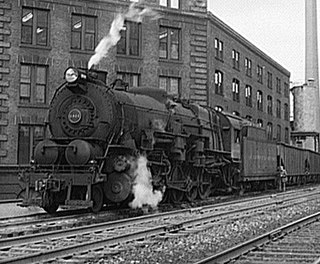
The Pennsylvania Railroad (PRR) class I1s steam locomotives were the largest class of 2-10-0 "Decapods" in the United States. From 1916 to 1923, 598 locomotives were produced. They were the dominant freight locomotive on the system until World War II and remained in service until 1957. Nicknames for the type included Decs and Hippos, the latter due to their large boiler.
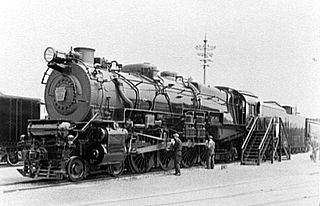
The M1 was a class of steam locomotive of the Pennsylvania Railroad (PRR). It was a class of heavy mixed-traffic locomotives of the 4-8-2 "Mountain" arrangement, which uses four pairs of driving wheels with a four-wheel guiding truck in front for stability at speed and a two-wheel trailing truck to support the large firebox needed for sustained power. Although built for both passenger and freight work, they spent most of their service lives hauling heavy high-speed freight trains. Many PRR men counted the M1 class locomotives as the best steam locomotives the railroad ever owned.

The Pennsylvania Railroad (PRR) class T1 duplex-drive 4-4-4-4 steam locomotives, introduced in 1942 with two prototypes and later in 1945-1946 with 50 production examples, were the last steam locomotives built for the PRR and arguably its most controversial. They were ambitious, technologically sophisticated, powerful, fast and distinctively streamlined by Raymond Loewy. However, they were also prone to wheelslip both when starting and at speed, in addition to being complicated to maintain and expensive to run. The PRR decided in 1948 to place diesel locomotives on all express passenger trains, leaving unanswered questions as to whether the T1's flaws were solvable, especially taking into account that the two prototypes did not have the problems inherent to the production units.
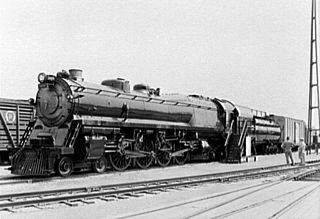
A 4-4-4-4 steam locomotive, in the Whyte notation for describing locomotive wheel arrangements, has a four-wheel leading truck, two sets of four driving wheels, and a four-wheel trailing truck. While it would be possible to make an articulated locomotive of this arrangement, the only 4-4-4-4s ever built were duplex locomotives—with two sets of cylinders driving two sets of driven wheels in one rigid frame, essentially a 4-8-4 with divided drive.
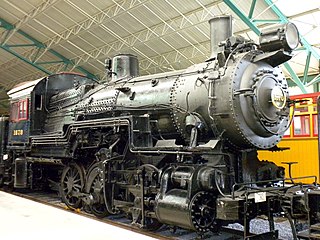
The Pennsylvania Railroad's class B6 was its most successful class of switcher locomotive, or as the PRR termed them "shifter". The PRR preferred the 0-6-0 wheel arrangement for larger switchers, whereas on other railroads the 0-8-0 gained preference. The PRR generally used 2-8-0s when larger power was required.

The Pennsylvania Railroad's S2 class was a steam turbine locomotive designed and built in a collaborative effort by Baldwin Locomotive Works and Westinghouse Electric & Manufacturing Company, as an attempt to prolong the dominance of the steam locomotive by adapting technology that had been widely accepted in the marine industry. One was built, #6200, delivered in September 1944. The S2 was the sole example of the 6-8-6 wheel arrangement in the Whyte notation, with a six-wheel leading truck keeping the locomotive stable at speed, eight powered and coupled driving wheels, and a six-wheel trailing truck supporting the large firebox. The S2 used a direct-drive steam turbine provided by the Westinghouse Electric & Manufacturing Company, geared to the center pair of axles with the outer two axles connected by side rods; the fixed gear ratio was 18.5:1. Such design was to prevent energy loss and S2 achieved a mechanical efficiency of 97% which means only 3% of steam energy was lost within the propulsion equipment. The disadvantage of a direct-drive steam turbine was that the turbine could not operate at optimal speeds over the locomotive's entire speed range. The S2 was the largest, heaviest and fastest direct-drive turbine locomotive design ever built.
The Pennsylvania Railroad's class K5 were experimental 4-6-2 "Pacific" types, built in 1929 to see if a larger Pacific than the standard K4s was worthwhile. Two prototypes were built, #5698 at the PRR's own Altoona Works, and #5699 by the Baldwin Locomotive Works. Although classified identically, the two locomotives differed in many aspects, as detailed below. They were both fitted with a much fatter boiler than the K4s, but dimensionally similar to those of the I1s 2-10-0 "Decapods". Most other dimensions were enlarged over the K4s as well; the exceptions being the 70 square feet (6.5 m2) grate area and the 80 in (2.032 m) drivers.

The PRR S1 class steam locomotive was a single experimental duplex locomotive of the Pennsylvania Railroad. It was designed to demonstrate the advantages of duplex drives espoused by Baldwin Chief Engineer Ralph P. Johnson. It was the longest and heaviest rigid frame reciprocating steam locomotive that was ever built. The streamlined Art Deco styled shell of the locomotive was designed by Raymond Loewy.
The Pennsylvania Railroad class Q1, #6130, was a single experimental steam locomotive designed for dual service. The locomotive entered service in 1942, and retired in 1949 after accumulating a relatively low 165,000 service miles.

Pennsylvania Railroad Class L1s were 2-8-2 "Mikado"-type steam locomotives that were used on the Pennsylvania Railroad during the early twentieth century. These 574 locomotives were manufactured between 1914 and 1919 by the railroad's own Juniata Shops as well as the Baldwin Locomotive Works (205) and the Lima Locomotive Works (25).
The Pennsylvania Railroad's steam locomotive class D4 (formerly Class C (anthracite), pre-1895) comprised thirty-seven anthracite-burning 4-4-0 locomotives intended for general passenger and freight service on the PRR's New Jersey lines, constructed at the railroad's own Altoona Works (now owned by Norfolk Southern) during 1873–1890. They shared many parts with other standard classes.
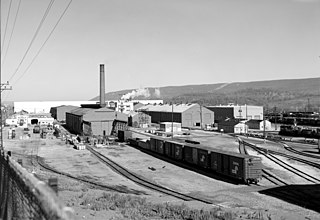
Altoona Works is a large railroad industrial complex in Altoona, Pennsylvania. It was built between 1850 and 1925 by the Pennsylvania Railroad (PRR), to supply the railroad with locomotives, railroad cars and related equipment. For many years, it was the largest railroad shop complex in the world.
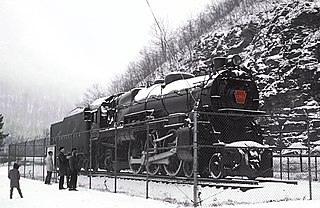
Pennsylvania Railroad 1361 is a 4-6-2 K4 "Pacific" type steam locomotive built in May 1918 by the Pennsylvania Railroad's (PRR) Juniata Shops in Altoona, Pennsylvania. It hauled mainline passenger trains in Pennsylvania and commuter trains in Central New Jersey on the PRR until its retirement from revenue service in 1956. Restored to operating condition for excursion service in 1987, No. 1361 and its only surviving sister locomotive, No. 3750, were designated as the official state steam locomotives by the Pennsylvania General Assembly. In 1988, it was sidelined due to mechanical problems and was currently owned by the Railroaders Memorial Museum (RMM) in Altoona, Pennsylvania, who were currently getting No. 1361 back to operation.
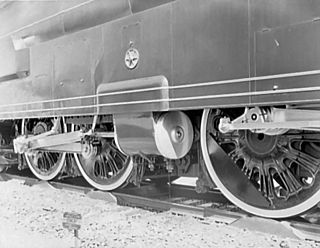
A duplex locomotive is a steam locomotive that divides the driving force on its wheels by using two pairs of cylinders rigidly mounted to a single locomotive frame; it is not an articulated locomotive. The concept was first used in France in 1863, but was particularly developed in the early 1930s by the Baldwin Locomotive Works, the largest commercial builder of steam locomotives in North America, under the supervision of its then chief engineer, Ralph P. Johnson.

Pennsylvania Railroad 5550 is a mainline duplex drive steam locomotive under construction in the United States. With an estimated completion by 2030, the locomotive will become the 53rd example of the Pennsylvania Railroad's T1 steam locomotive class and the only operational locomotive of its type, as well as the largest steam locomotive built in the United States since 1952. The estimated cost of PRR 5550 was originally $10 million, but an updated projected cost of $7 million was released with the acquisition of an existing long-haul tender from the Western New York Railway Historical Society in August 2017. Construction began in 2014 with the casting of the locomotive's keystone-shaped number plate. As of February 2024 the locomotive was 43% complete.
The Pennsylvania Railroad's class K29s comprised a single experimental 4-6-2 "Pacific" type steam locomotive. Constructed by Alco-Schenectady, it was given road number 3395. Although only one demonstrator was constructed, the K29s would become the basis for the highly successful K4s Pacifics and L1s Mikados. The lone example spent most of its life on the PRR's Pittsburgh division main line and was retired around 1929.















